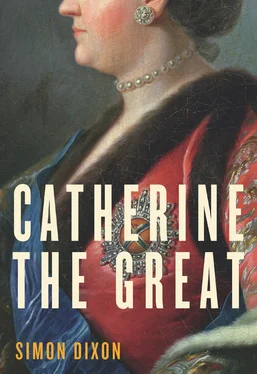* * *
Six months later, the voyage to the South seemed no more than ‘a dream’. 96Aggravated by Potëmkin’s aggressive posturing in the Crimea, the Turks had imprisoned Catherine’s ambassador in Constantinople soon after her return to St Petersburg. This was the traditional Ottoman way of declaring war. Fortified by her implacable faith in Potëmkin, Catherine expected her troops to make a better start to the campaign than they had in 1768. But her partner was in no fit state to lead the charge. Exhausted by the summer’s celebrations and alarmed by a diarrhoea epidemic at Kherson (Catherine ordered him to cure the sick with rice and a tot of fortified wine), he sank into a debilitating bout of hypochondria. ‘In truth, I’m not sure I can stand this for long,’ he warned on 16 September. ‘I can neither sleep nor eat…When can I retire or cut myself off so that the world will hear of me no more?!’ Eight days later, when a storm threatened to destroy his precious fleet at Sevastopol, he seemed a broken man: ‘My mind and spirit are gone. I have requested that my command be transferred to another.’ Catherine initially responded to such wailing with a combination of encouragement and reassurance that prompted the prince to acknowledge that ‘you genuinely write to me like my own mother’. By early October, however, tolerance had given way to irritation. Her affairs demanded unshakeable patience, she chided him, whereas he was ‘as impatient as a five-year-old’. She was far from serene herself: ‘There is one way to lessen my anxiety,’ she declared on 9 October: ‘write more often and inform me about the state of affairs. I await the promised details with impatience. And don’t forget to write to me about Kinburn.’ 97
In the event, the details were unexpectedly encouraging. Potëmkin recovered both his health and his energy; his fleet, though damaged, had escaped destruction; and, thanks to General Suvorov, Kinburn, the Russian fort at the mouth of the Dnieper, successfully resisted the bombardment to which it had been subjected since August. The respite, however, was only temporary. Now it was Catherine’s turn to suffer: she complained of sickness and headaches throughout the winter and was so ill in the spring that on 11 April 1788, just before her fifty-ninth birthday, The Times prematurely announced her death. Neither the Russians nor the Austrians, who belatedly came to Catherine’s aid in February 1788, made much progress that summer. Joseph II proved a limited general and his troops were stymied by disease. The mercurial Potëmkin had to be dissuaded from abandoning the Crimea to the Turks: ‘When you are sitting on a horse,’ Catherine pointed out, ‘there is no point in dismounting and holding on by the tail.’ Instead, he committed himself to a lengthy siege of Ochakov, the Turkish fort opposite Kinburn, whose 24,000-strong garrison trapped the Russian fleet in the Dnieper estuary. Thanks to an attack by gunboats armed by Samuel Bentham, the Turks lost fifteen ships in two days in June (Catherine donned naval uniform for the exultant Te Deum at Tsarskoye Selo). Yet attempts in the following month to blockade the fort proved inconclusive and heavy snow in November prevented Potëmkin from delivering Ochakov to the empress as a gift on her name day. Not until 6 December did he launch a full-scale attack. Ten days later, Catherine learned of the fall of the fortress, the main aim of her strategy since the beginning of the conflict. ‘I grasp you by the ears with both hands and kiss you in my thoughts, dearest friend.’ 98
Plagued with headaches, she had been sleepless for days. Now she caught a chill at the Te Deum in celebration of the victory, complaining to Khrapovitsky of an unbearable backache that left her tossing and turning until four in the morning. 99It had not been an easy year. That summer, while Catherine was diverted by her campaign against the Turks, Gustav III had grasped the opportunity to limit Russian interference in Swedish politics by bombarding the Russian fort at Nyslott on 22 June. (Since his constitution prevented him from appearing to be the aggressor, the attack was launched in pseudo-retaliation against a raid into Swedish territory by a ‘Cossack’ band from Russian Finland, alleged at the time to be Swedish troops wearing costumes borrowed from the royal opera in Stockholm.) 100Admiral Greig came to the rescue for one last time by holding off the Swedish fleet at a brutal stalemate off the island of Hogland on 6 July. Catherine, who sent Dr Rogerson to minister to her feverish admiral, mourned Greig’s death at Reval on 15 October as a ‘great loss to the state’ and paid for his funeral. By then, she herself had survived one of her nerviest summers under threat of a Swedish descent on her palace. St Petersburg resembled an armed camp as regiment after regiment assembled for its defence. ‘This is a difficult time for me,’ Catherine admitted to Potëmkin on 3 July. Yet even an enervating heatwave failed to blunt her competitive edge. ‘The heat was so great here,’ she wrote a fortnight later, ‘that the thermometer registered over 39 and a half degrees in the sun. In Portugal they can’t remember anything higher than 44.’ 101
Over the following winter, a tearful empress faced divisions within her own Council, as her determination to maintain the Austrian alliance and to prop up King Stanislaw in Poland (a policy supported by Bezborodko, Zavadovsky and Alexander Vorontsov) came under pressure from those who favoured a compromise with Prussia at the Poles’ expense. By far the most important of these was Potëmkin himself, who had built up his Polish estates to the point where he owned 112,000 serfs. In the spring of 1789, having sent Catherine a map outlining his plans for the occupation of three Polish provinces (Bratslav, Kiev and Podolia), he travelled to St Petersburg in a vain attempt to persuade Catherine to change her course. While he returned to the South in May, the empress renewed her Austrian alliance in a further exchange of letters with Joseph II. 102
She did so against a background of personal crisis when it emerged that ‘Redcoat’ Mamonov had betrayed her with one of her maids of honour, Princess Darya Shcherbatova. As her courtiers noticed, the cracks had been opening in Catherine’s relationship with her favourite for some months, prompting tears and bad temper. She spent her sixtieth birthday—one of the most significant state occasions in the Court calendar—closeted in her rooms. 103Mamonov’s request for permission to marry his lover was the ultimate blow. As she confessed in a self-styled ‘apophthegm’ to Potëmkin on 29 June, ‘I nearly fell over, so great was my surprise, and had still not recovered when he came into my room, fell at my feet and confessed his whole intrigue.’ 104Despite copious tears, meticulously recorded by Mamonov’s friend Alexander Khrapovitsky, Catherine betrothed the couple herself and sent them to Moscow. This time there was to be no lonely interlude between lovers. On the day of Mamonov’s dismissal, her friend Anna Naryshkina introduced her to the young man who was to be her last and youngest favourite. The swarthy Platon Zubov, thirty-eight years Catherine’s junior, was promptly dubbed ‘the little black one’ in the apophthegm to Potëmkin, which outlined all the usual virtues of gentleness, eagerness and modesty (a singular misapprehension of the new favourite’s nature).
It was in Zubov’s company that the empress faced the outbreak of the French Revolution in July 1789. Though no friend of sedition, Catherine initially had little reason to fear events in Paris, and indeed could reasonably hope to profit from French weakness in the international arena. Her subjects could read about the fall of the Bastille in the Russian newspapers (whose circulation increased in response to such exciting developments), and many also had access to the range of French revolutionary pamphlets and news-sheets which circulated freely in St Petersburg and Moscow. 105One reason for the empress’s confidence was the good news she received from the Southern front, where Potëmkin and General Suvorov were enjoying a triumphant summer on the Bug and the Dniester. After 15,000 Turks were slaughtered on the River Rymnik on 11 September, Suvorov was made a count of both the Russian Empire and the Holy Roman Empire, and allowed to call himself ‘Rymniksky’ at Potëmkin’s suggestion. 106Wider European developments, however, prevented Catherine from converting military victories into a peaceful settlement on her own terms. British hostility was an increasing hazard for her, and so were Prussia’s ambitions in Poland. ‘We are stroking the Prussians,’ she told Potëmkin in October 1789, ‘but how our heart can endure their words and deeds which are filled with rudeness and abuse, God alone knows.’ 107
Читать дальше












